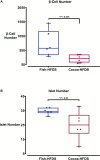Differential effects of fish-oil and cocoa-butter based high-fat/high-sucrose diets on endocrine pancreas morphology and function in mice
- PMID: 38414818
- PMCID: PMC10897036
- DOI: 10.3389/fendo.2024.1265799
Differential effects of fish-oil and cocoa-butter based high-fat/high-sucrose diets on endocrine pancreas morphology and function in mice
Abstract
Introduction: A high-fat/high-sucrose diet leads to adverse metabolic changes that affect insulin sensitivity, function, and secretion. The source of fat in the diet might inhibit or increase this adverse effect. Fish oil and cocoa butter are a significant part of our diets. Yet comparisons of these commonly used fat sources with high sucrose on pancreas morphology and function are not made. This study investigated the comparative effects of a fish oil-based high-fat/high-sucrose diet (Fish-HFDS) versus a cocoa butter-based high-fat/high-sucrose diet (Cocoa-HFDS) on endocrine pancreas morphology and function in mice.
Methods: C57BL/6 male mice (n=12) were randomly assigned to dietary intervention either Fish-HFDS (n=6) or Cocoa-HFDS (n=6) for 22 weeks. Intraperitoneal glucose and insulin tolerance tests (IP-GTT and IP-ITT) were performed after 20-21 weeks of dietary intervention. Plasma concentrations of c-peptide, insulin, glucagon, GLP-1, and leptin were measured by Milliplex kit. Pancreatic tissues were collected for immunohistochemistry to measure islet number and composition. Tissues were multi-labelled with antibodies against insulin and glucagon, also including expression on Pdx1-positive cells.
Results and discussion: Fish-HFDS-fed mice showed significantly reduced food intake and body weight gain compared to Cocoa-HFDS-fed mice. Fish-HFDS group had lower fasting blood glucose concentration and area under the curve (AUC) for both GTT and ITT. Plasma c-peptide, insulin, glucagon, and GLP-1 concentrations were increased in the Fish-HFDS group. Interestingly, mice fed the Fish-HFDS diet displayed higher plasma leptin concentration. Histochemical analysis revealed a significant increase in endocrine pancreas β-cells and islet numbers in mice fed Fish-HFDS compared to the Cocoa-HFDS group. Taken together, these findings suggest that in a high-fat/high-sucrose dietary setting, the source of the fat, especially fish oil, can ameliorate the effect of sucrose on glucose homeostasis and endocrine pancreas morphology and function.
Keywords: cocoa butter; fish oil; glucagon; high-fat/sucrose diet; insulin; α-cell; β-cell.
Copyright © 2024 Albeloushi, Hasan, Arefanian, Sindhu, Al-Rashed, Kochumon, Abukhalaf, Jacob, Shenouda, Al Madhoun, Al-Mulla and Ahmad.
Conflict of interest statement
The authors declare that the research was conducted in the absence of any commercial or financial relationships that could be construed as a potential conflict of interest.
Figures






Similar articles
-
Gut Dysbiosis Shaped by Cocoa Butter-Based Sucrose-Free HFD Leads to Steatohepatitis, and Insulin Resistance in Mice.Nutrients. 2024 Jun 18;16(12):1929. doi: 10.3390/nu16121929. Nutrients. 2024. PMID: 38931284 Free PMC article.
-
Moderate Exercise Training Combined With a High-Fat and Sucrose Diet Protects Pancreatic Islet Function in Male C57BL/6J Mice.Front Endocrinol (Lausanne). 2022 May 20;13:881236. doi: 10.3389/fendo.2022.881236. eCollection 2022. Front Endocrinol (Lausanne). 2022. PMID: 35669687 Free PMC article.
-
Adipose tissue, liver and pancreas structural alterations in C57BL/6 mice fed high-fat-high-sucrose diet supplemented with fish oil (n-3 fatty acid rich oil).Exp Toxicol Pathol. 2010 Jan;62(1):17-25. doi: 10.1016/j.etp.2008.12.008. Epub 2009 Jan 30. Exp Toxicol Pathol. 2010. PMID: 19186042
-
Elimination of glucagon-like peptide 1R signaling does not modify weight gain and islet adaptation in mice with combined disruption of leptin and GLP-1 action.Diabetes. 2000 Sep;49(9):1552-60. doi: 10.2337/diabetes.49.9.1552. Diabetes. 2000. PMID: 10969840
-
High-Fat Diet and Altered Radiation Response.Biology (Basel). 2025 Mar 22;14(4):324. doi: 10.3390/biology14040324. Biology (Basel). 2025. PMID: 40282189 Free PMC article. Review.
Cited by
-
Effects of Five Dietary Carbohydrate Sources on Growth, Glucose Metabolism, Antioxidant Capacity and Immunity of Largemouth Bass (Micropterus salmoides).Animals (Basel). 2024 May 17;14(10):1492. doi: 10.3390/ani14101492. Animals (Basel). 2024. PMID: 38791708 Free PMC article.
References
-
- Samane S, Christon R, Dombrowski L, Turcotte S, Charrouf Z, Lavigne C, et al. . Fish oil and argan oil intake differently modulate insulin resistance and glucose intolerance in a rat model of dietary-induced obesity. Metabolism: Clin Exp. (2009) 58:909–19. doi: 10.1016/j.metabol.2009.02.013 - DOI - PubMed
Publication types
MeSH terms
Substances
LinkOut - more resources
Full Text Sources
Medical

